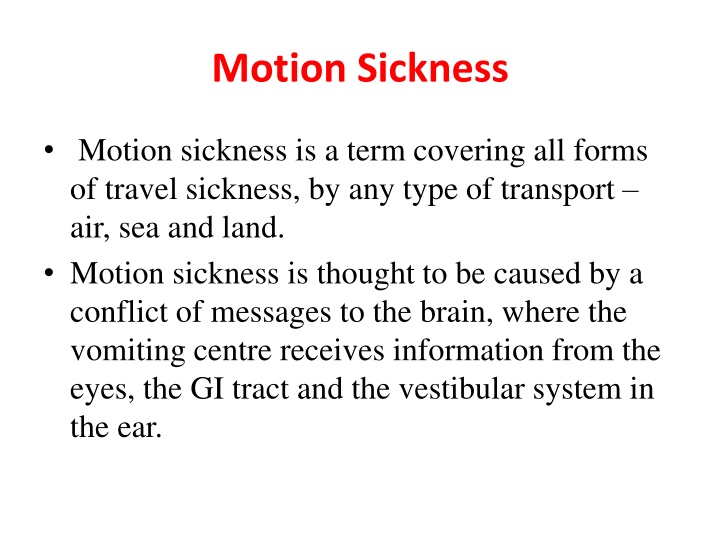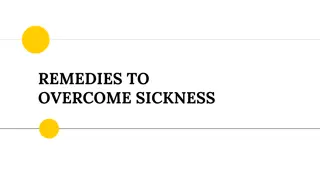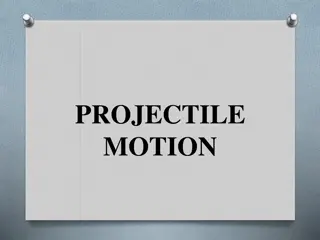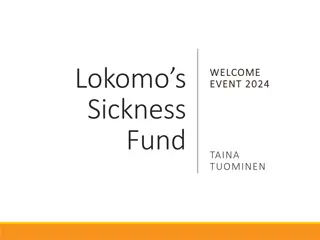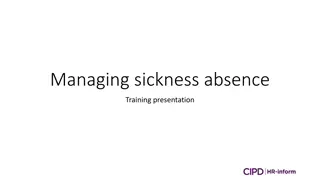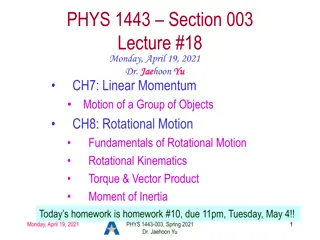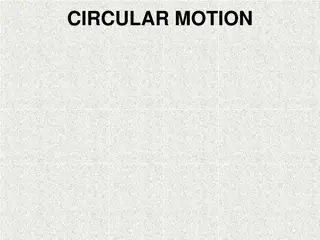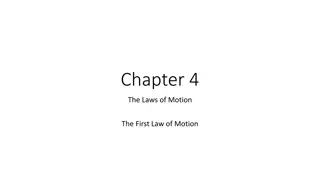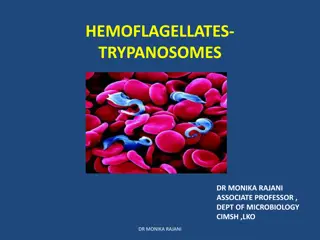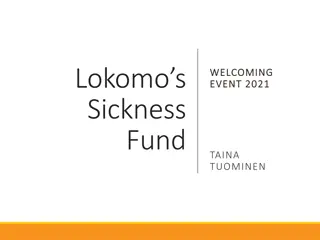Motion Sickness Symptoms and Treatment
Motion sickness, a form of vertigo, includes symptoms like nausea, vomiting, increased salivation, and pallor. Treatment options include antihistamines and anticholinergic agents like hyoscine hydrobromide. Obesity, associated with health issues like cardiovascular disease and diabetes, can be exacerbated by factors like depression and lack of physical activity.
Download Presentation

Please find below an Image/Link to download the presentation.
The content on the website is provided AS IS for your information and personal use only. It may not be sold, licensed, or shared on other websites without obtaining consent from the author.If you encounter any issues during the download, it is possible that the publisher has removed the file from their server.
You are allowed to download the files provided on this website for personal or commercial use, subject to the condition that they are used lawfully. All files are the property of their respective owners.
The content on the website is provided AS IS for your information and personal use only. It may not be sold, licensed, or shared on other websites without obtaining consent from the author.
E N D
Presentation Transcript
Motion Sickness Motion sickness is a term covering all forms of travel sickness, by any type of transport air, sea and land. Motion sickness is thought to be caused by a conflict of messages to the brain, where the vomiting centre receives information from the eyes, the GI tract and the vestibular system in the ear.
Symptoms Motion sickness is a form of vertigo in which autonomic symptoms predominate. It may include, in addition to nausea and vomiting, increased salivation, general malaise, pallor, sweating, and hyperventilation. Gastric motility is reduced and digestion impaired.
Significance of questions and answers 1-Age: common in young children, the incidence of seems to greatly reduce with age. 2-Length of travel: help the pharmacist in the selection of prophylactic treatment. 3-Previous history and medication pharmacist enquire about any treatments used in the past for motion sickness and their level of success or failure.
Treatment Antihistamines Anticholinergic effects are thought to be responsible for the effectiveness of antihistamines in the prophylaxis of motion sickness. All have the potential to cause drowsiness and promethazine appears to be the most sedative. Meclozine and promethazine theoclate have long durations of action and are useful for long journeys since they need to be taken only once daily.
Anticholinergic agents hyoscine hydrobromide (scopolamine): its most effective, but more SE (SE???). It can be given to children over 3 years. Hyoscine suitable for shorter journeys and should be given as tab. (150-300 mcg) 20 min before journey. SE:???, Children could be given sweets to suck to counteract any drying of the mouth. Hyosine patch: designed to get long action (up to 72hr), applied to hairless area behind ear 5-6 hr before journey. Not suitable for child < 10 y.
Obesity It is associated with many health problems including :- cardiovascular disease, diabetes mellitus, gallstones and osteoarthritis. Factors that aggravate obesity may include depression, other psychosocial problems, and some drugs.
Causes The main causes of obesity are increased consumption of energy-dense foods and reduced physical activity. Diagnosis Overweight and obesity are measured in terms of: 1-Body mass index (BMI) 2- Waist circumference.
Management Non Pharmacological Weight reduction is achieved through reduction in calorific intake, particularly saturated fats and high glycaemic index carbohydrates, combined with increased physical activity. Pharmacological Orlistat is licensed, in conjunction with a mildly hypocaloric diet, for the treatment of overweight patients (BMI>28) aged 18 years or over.
Mode of action Orlistat is a specific long-acting inhibitor of gastrointestinal lipases. The inactivated enzyme is thus unavailable to hydrolyse dietary fat, and the fat is eliminated from the body in faeces. Dose: Orlistat (xenical) 60-mg capsule is OTC. Given before, during or up to 1 hour after eachmain meal. Orlistat may be used for up to 6 months, but patients should be referred to a doctor if there is no weight loss within 12 weeks.
Side-effects and cautions abdominal pain or discomfort, oily spotting from the rectum, flatus with discharge, faecal urgency, fatty or oily stools, flatulence, liquid stools and increased defecation. DI:???
Notes: Drugs should never be used as the sole element of treatment. The individual should be monitored on a regular basis drug treatment should be discontinued if the individual regains weight at any time whilst receiving drug treatment. Combination therapy involving more than one antiobesity drug is contra-indicated Thyroid hormones have no place in the treatment of obesity except in biochemically proven hypothyroid patients. The use of diuretics, chorionic gonadotrophin, or amfetamines is not appropriate for weight reduction.
